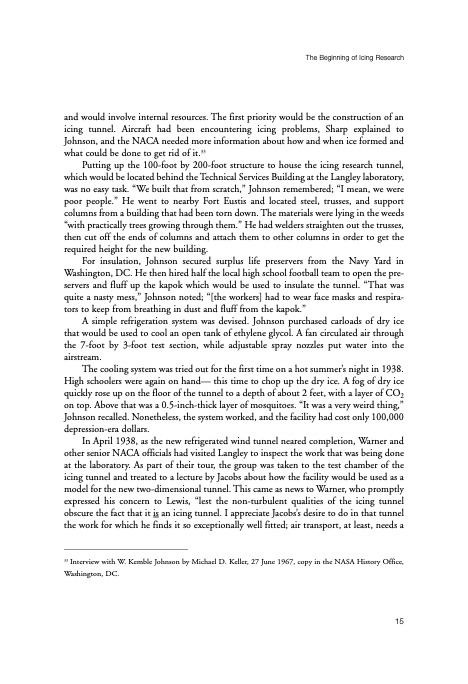
PDF Publication Title:
Text from PDF Page: 028
and would involve internal resources. The first priority would be the construction of an icing tunnel. Aircraft had been encountering icing problems, Sharp explained to Johnson, and the NACA needed more information about how and when ice formed and what could be done to get rid of it.33 Putting up the 100-foot by 200-foot structure to house the icing research tunnel, which would be located behind the Technical Services Building at the Langley laboratory, was no easy task. “We built that from scratch,” Johnson remembered; “I mean, we were poor people.” He went to nearby Fort Eustis and located steel, trusses, and support columns from a building that had been torn down. The materials were lying in the weeds “with practically trees growing through them.” He had welders straighten out the trusses, then cut off the ends of columns and attach them to other columns in order to get the required height for the new building. For insulation, Johnson secured surplus life preservers from the Navy Yard in Washington, DC. He then hired half the local high school football team to open the pre- servers and fluff up the kapok which would be used to insulate the tunnel. “That was quite a nasty mess,” Johnson noted; “[the workers] had to wear face masks and respira- tors to keep from breathing in dust and fluff from the kapok.” A simple refrigeration system was devised. Johnson purchased carloads of dry ice that would be used to cool an open tank of ethylene glycol. A fan circulated air through the 7-foot by 3-foot test section, while adjustable spray nozzles put water into the airstream. The cooling system was tried out for the first time on a hot summer’s night in 1938. High schoolers were again on hand— this time to chop up the dry ice. A fog of dry ice quickly rose up on the floor of the tunnel to a depth of about 2 feet, with a layer of CO2 on top. Above that was a 0.5-inch-thick layer of mosquitoes. “It was a very weird thing,” Johnson recalled. Nonetheless, the system worked, and the facility had cost only 100,000 depression-era dollars. In April 1938, as the new refrigerated wind tunnel neared completion, Warner and other senior NACA officials had visited Langley to inspect the work that was being done at the laboratory. As part of their tour, the group was taken to the test chamber of the icing tunnel and treated to a lecture by Jacobs about how the facility would be used as a model for the new two-dimensional tunnel. This came as news to Warner, who promptly expressed his concern to Lewis, “lest the non-turbulent qualities of the icing tunnel obscure the fact that it is an icing tunnel. I appreciate Jacobs’s desire to do in that tunnel the work for which he finds it so exceptionally well fitted; air transport, at least, needs a The Beginning of Icing Research 33 Interview with W. Kemble Johnson by Michael D. Keller, 27 June 1967, copy in the NASA History Office, Washington, DC. 15PDF Image | History of NASA Icing Research Tunnel

PDF Search Title:
History of NASA Icing Research TunnelOriginal File Name Searched:
sp4226.pdfDIY PDF Search: Google It | Yahoo | Bing
NFT (Non Fungible Token): Buy our tech, design, development or system NFT and become part of our tech NFT network... More Info
IT XR Project Redstone NFT Available for Sale: NFT for high tech turbine design with one part 3D printed counter-rotating energy turbine. Be part of the future with this NFT. Can be bought and sold but only one design NFT exists. Royalties go to the developer (Infinity) to keep enhancing design and applications... More Info
Infinity Turbine IT XR Project Redstone Design: NFT for sale... NFT for high tech turbine design with one part 3D printed counter-rotating energy turbine. Includes all rights to this turbine design, including license for Fluid Handling Block I and II for the turbine assembly and housing. The NFT includes the blueprints (cad/cam), revenue streams, and all future development of the IT XR Project Redstone... More Info
Infinity Turbine ROT Radial Outflow Turbine 24 Design and Worldwide Rights: NFT for sale... NFT for the ROT 24 energy turbine. Be part of the future with this NFT. This design can be bought and sold but only one design NFT exists. You may manufacture the unit, or get the revenues from its sale from Infinity Turbine. Royalties go to the developer (Infinity) to keep enhancing design and applications... More Info
Infinity Supercritical CO2 10 Liter Extractor Design and Worldwide Rights: The Infinity Supercritical 10L CO2 extractor is for botanical oil extraction, which is rich in terpenes and can produce shelf ready full spectrum oil. With over 5 years of development, this industry leader mature extractor machine has been sold since 2015 and is part of many profitable businesses. The process can also be used for electrowinning, e-waste recycling, and lithium battery recycling, gold mining electronic wastes, precious metals. CO2 can also be used in a reverse fuel cell with nafion to make a gas-to-liquids fuel, such as methanol, ethanol and butanol or ethylene. Supercritical CO2 has also been used for treating nafion to make it more effective catalyst. This NFT is for the purchase of worldwide rights which includes the design. More Info
NFT (Non Fungible Token): Buy our tech, design, development or system NFT and become part of our tech NFT network... More Info
Infinity Turbine Products: Special for this month, any plans are $10,000 for complete Cad/Cam blueprints. License is for one build. Try before you buy a production license. May pay by Bitcoin or other Crypto. Products Page... More Info
| CONTACT TEL: 608-238-6001 Email: greg@infinityturbine.com | RSS | AMP |